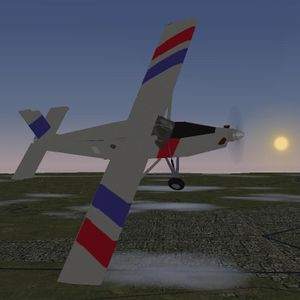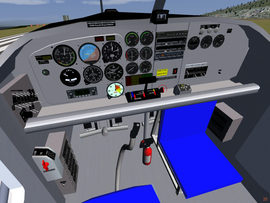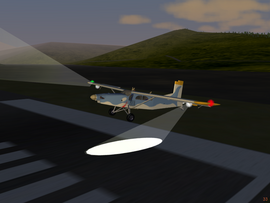Pilatus PC-6 Porter: Difference between revisions
Jump to navigation
Jump to search
No edit summary |
No edit summary |
||
| Line 8: | Line 8: | ||
|3dcockpit =yes | |3dcockpit =yes | ||
|authors = Detlef Faber, JeeP cheney | |authors = Detlef Faber, JeeP cheney | ||
|fgname = PC-6- | |fgname = PC-6-B2H4 | ||
}} | }} | ||
Revision as of 14:45, 2 September 2011
 | |
| Type | 1 engine utility |
|---|---|
| Author(s) | Detlef Faber, JeeP cheney |
| FDM | YASim |
| --aircraft= | PC-6-B2H4 |
| Status | Production |
Pilatus PC-6 Porter is a 1 engine utility airplane.
The PC-6 is famous in the aviation world for its Short Take-off and Landing (STOL) performance on almost any type of terrain; it can take-off within a distance of 195 metres (640 ft) and land within a distance of 130 metres (427 ft) while carrying a payload of 1,500 kg (3,300 lb).
Notes to Pilots
| Ctrl-l | toggle Tailwheel Lock |
Takeoff
- Flaps down 10 degrees.
- Apply 100% Engine RPM While accelerating raise the tail.
- Be prepared to use Rudder to counteract Swing.
Climb and cruise
- The plane picks up speed fast so be sure to raise Flaps below 80 kts.
- The best climb speed is 80-90 kts.
- Cruise Power is at 90% Engine RPM.
Landing
- Lower Flaps under 80 kts and set Prop to Max RPM.
- Approach Speed is 60-70 kts.
- Approach the threshold with 60 kts.
- Don't reduce power too early as the idle prop acts as effective speed brake.
Features
complete 3D Cockpit with lots of controllable switches
engine and structural failure simulation
Co Pilot comments
Livery selection
Related content
- Pilatus PC-7 (1 turboprop), available for FG 1.0.
Links
| ||||||||

